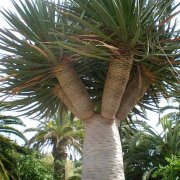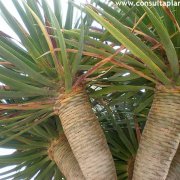Care of the tree Dracaena draco or Dragon tree |
|
The genus Dracaena, family Asparagaceae, comprises 40 species of trees and shrubs native to Africa, Asia and Central America. Some species are: Dracaena draco, Dracaena fragrans, Dracaena marginata, Dracaena surculosa, Dracaena sanderiana, Dracaena reflexa. Common names: Dragon tree, Drago, Canary Islands dragon tree. This species is native to the Canary Islands, Cape Verde, Madeira, and western Morocco. They are arboreal plants with a thick branched trunk that resemble the Yuccas; they reach 10 meters (32.8 feet) in height. The leaves are tapered and bluish-green in color. The yellowish flowers are not decorative and appear in large clusters above the foliage. They bloom in spring. They produce globose fruits that are green and then orange. These very slow-growing plants are used as isolated specimens, in rockery, in groups of few specimens or in pots for greenhouses, patios and terraces. Dracaena draco can grow in full sun or semi-shade exposure. In winter the temperature should be above 5 ºC (41 ºF); in winter it prefers a rest at 8-10 ºC (46-50 ºF). The soil can be a mixture of 1/3 leaf mulch, 1/3 garden substrate, and 1/3 coarse sand. In case of transplantation, it's done in spring with great care because its roots are quite delicate. Always water moderately, waiting for the substrate to be dry; in summer water 2-3 times a week if it is very hot. Fertilize with compost in early spring. Prune dry leaves and wilted flower stalks. Dragon tree is quite resistant to the usual pests but is sensitive to fungal diseases due to excess moisture. Canary Islands dragon tree propagates by seeds sown in a slightly damp sandy substrate or by stem cuttings; both processes are very slow. It's best to buy new specimens at garden centers, nurseries, or plant stores. |
Images of the tree Dracaena draco or Dragon tree |
Find plants
Dracaena draco or Dragon tree | Care and Growing
© 2025 FavThemes





